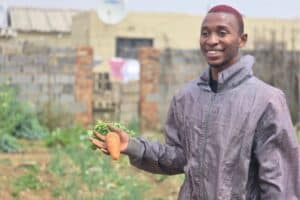Carrots, beetroot, onions, leeks, kohlrabi and turnips are all autumn veggies that are good for roasting, stews and soups.

The recent rainy weather has been a mixed blessing for the vegetable garden, with some veggies looking increasingly bedraggled while others are thriving.
Marlaen Straathof of Kirchhoffs is the first to admit that the veggies she planted in September are worse for wear and her advice is pull them out. That creates space for planting autumn and winter veggies and reduces the risk of disease.
Frequent heavy rains equal lots of vegetable disease problems, says Straathof, and these are caused by waterlogged soil. Plants can be affected by fungal and bacterial diseases that manifest as spots on the leaves, blotches, rust, rot and wilting.
Her advice is to protect healthy vegetables by spraying with a copper-based fungicide like Coppercount as soon as the rain tapers off.
Disease is also spread by working in the garden while the plants are wet, and by not cleaning garden equipment after use. Washing in hot soapy water does the trick. Other ways to limit disease include removing diseased leaves, or the entire plant, and keeping beds free of weeds.
https://www.instagram.com/p/Bo0uGd-nqn0/
The best long-term solution is to build raised vegetable beds as these have the best drainage and roots don’t sit in water. Where possible, rotate crops so that the same crop is not planted in the same soil all the time. This reduces soil-borne pathogens.
The second step to recovery the veggie garden is to fertilise. Nutrients are leached out by the heavy rain, says Straathof, and nutrient-deficient plants are also more susceptible to disease. This is particularly true of veggies grown in containers.
Once the weather has stabilised, fertilise with Vigorosa 5:1:5 which has a balance of nutrients for fruiting and leafy vegetables or use Margaret Roberts Organic Supercharger as a liquid fertiliser. Water well after applying Vigorosa.
Early March is a good time to plant many autumn and winter veggies that prefer cooler temperatures, and germination should be excellent in the moist soil.
Carrots, beetroot, onions, leeks, kohlrabi and turnips are all autumn veggies that are good for roasting, stews and soups. Sown now, they should be ready for harvesting by June onwards.
Also sow a new batch of leafy greens like lettuce, rocket, and Swiss chard, with additional winter greens like cabbage, kale, and Pak choi (Chinese cabbage). This is the last month to sow cauliflower because plants need to be well established before the frost.
https://www.instagram.com/p/BgXRnfylnq6/
Heirloom varieties always offer something different and the following are supplied by RAW seed:
• Kohlrabi “White Vienna” goes back to the Romans, when it was grown in the Imperial Gardens of Emperor Charlemagne. It is easy to grow, produces above ground “bulbs” which have cream-coloured flesh that tastes mildly of broccoli with hints of apple;
• Radicchio “Red Treviso” is a beautiful Italian heirloom veggie for winter salads. It has tender, slightly bitter red leaves with a white mid-rib, and forms a slender, cabbage-like head. Space plants 20cm apart and keep well-watered;
• Pak choi is an heirloom Chinese cabbage with crisp, tender leaves that have a slight mustard tang. The thick white stalks are also edible. It can be • eaten raw, or in soups and stir-fries; and
• Cauliflower Romanesco looks like a cross between broccoli and an unidentified flying object, but it has a lovely nutty flavour. It’s a 16th century Italian cauliflower that’s apple green, equally crisp.
For more news your way, download The Citizen’s app for iOS and Android.






